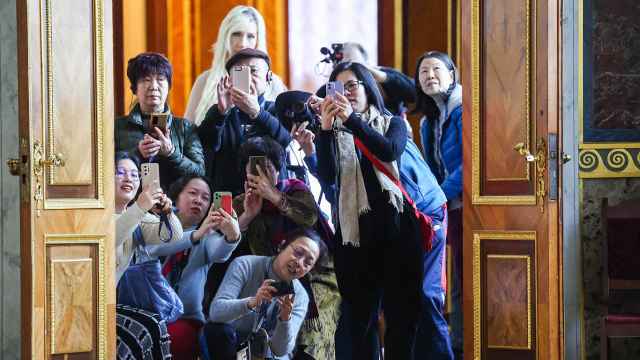When I first arrived in Russia in 2002, I assumed I was a little above average regarding my cultural literacy. I had been an art dealer for many years, lived in the sophisticated San Francisco Bay Area for six years, was an avid reader, had traveled extensively and enjoyed visiting most of the famous art museums of Europe. But after my first year in Russia, I realized that in comparison to the average Russian, I was way behind when it came to knowledge and appreciation of the arts.
On the final day of my first class in Moscow, the students told me they had prepared a graduation ceremony. One woman recited a poem by Alexander Pushkin, and a male student quoted lengthy passages from Leo Tolstoy and Fyodor Dostoevsky. I was surprised to note that almost everyone in the group spoke the lines along with the presenters. After an amusing skit, the program ended with a guy playing a guitar and the whole class singing and dancing. I have had students from 37 countries and never have had a group that was so spontaneously creative.
In the past 10 years, it has been interesting to compare my Russian students with other nationalities. In our classes, the participants are asked to produce many drawings. Artistic ability is not a requirement. But I was surprised to note that in my Russian classes, about 80 percent of the drawings were very good — a much higher percentage than my other classes in different countries. Russians, it would seem, have exceptional artistic talents that also have been nurtured and encouraged by their culture.
As a culture, Russia is especially attuned to the arts and places great value upon exposing their children to music, poetry, literature, art and drama. This was true in Soviet times and also exists in many Russian schools today. My great-nephew who lived in Krasnodar was required to recite pages of Tolstoy by memory in perfect Russian starting in second grade.
While the U.S. acknowledges the value of the arts, it gives more emphasis to science, technology, math and athletics — especially in educational systems. Russians also value these subjects and activities but, in the U.S., if a local or state government has to make a budget cut in their schools, the arts are almost always the first to go.
Russians are also great readers. As schoolchildren, they loved not only the Russian classics but were always excited if they were able to obtain the few American novels not on the censored list during the Soviet period. Stories that escaped the censors often were ones in which blacks, Native Americans other minorities, or the poor were mistreated by white Americans. "The Adventures of Tom Sawyer" and "The Adventures of Huckleberry Finn" by Mark Twain and "The Last of the Mohicans" by James Fenimore Cooper were among their favorites. Once the Iron Curtain fell, Russians were glad to at last obtain copies of many of the books to which they had been long denied. Many Russians devoured them.
When six of my Russian colleagues visited Arizona several years ago, I was amused when one of them asked a new American friend, "Please tell me, how do you think Ernest Hemingway and F. Scott Fitzgerald compare to Tolstoy and Dostoevsky?" The American looked embarrassed and had to admit he had never read Tolstoy or Dostoevsky. The Russians were surprised. They had assumed that because Americans have had open access to the great literature of the world, they would have taken advantage of such a special privilege and be knowledgeable, especially regarding authors who were so highly esteemed.
When I first started riding the metro in Moscow, I enjoyed observing what people were reading. Ten years ago, out of 40 people in one train, at least half would be reading: two with a magazine, four with a newspaper and the remaining 14 would have a hardcover book. I knew that in the U.S., hardcover books definitely would have been in the minority. Today however, Russians in the metro look more and more like the rest of the world with their cell phones, e-readers, computers, MP3 players and earphones. Unfortunately, books are being replaced by technology.
I have visited my favorite Russian art museum, the Tretyakov Gallery, 15 times and am always impressed to see many groups of schoolchildren aptly listening to a docent describe each work of art. I also am pleased to see many teenagers and young adults there on their own. The same holds true for concerts at the Tchaikovsky Concert Hall.
Poetry for many Russians contains a spiritual quality. One friend told me: "We were very poor, and my mother often took me with her as she scrubbed office floors at night. She would quote Pushkin as she worked and tell me that the words would cleanse my soul just as the water from her bucket cleansed the floor." In 2007, there was a special event commemorating the 170th anniversary of Pushkin's death that featured a poetry reading and a concert at the Pushkin Museum. I arrived an hour early only to find a standing-room-only crowd. I was amazed to see an audience of all ages packed together to honor a poet born in the 18th century and even more surprised to see almost everyone mouth the words to Pushkin's creations. I could not imagine a crowd of this size gathering in the U.S. for a poetry reading.
Some of my Russian colleagues interested in American culture have asked me about Native American art since they know I have several Native American artists as friends. I recounted what a gallery colleague who was raised on the Navajo reservation and also knew Native Americans from many tribes once told me: "Native Americans have a unique ability for art. I have found if you give the correct equipment and material to any Native American, he or she is capable of creating something very beautiful — whether it be a painting, sculpture, rug, basket, bead work, piece of pottery or an exquisite piece of jewelry. All the Native Americans I know are innately, artistically talented."
When I taught in the Sakha republic, I was intrigued by the fact that many of the indigenous people reminded me so much of my Native American friends. I realize that Alaska and Russia are only a few kilometers apart and that the ancients surely must have migrated back and forth across the continents. It would be interesting to research if the innate talents for the arts manifested in a large portion of the population of Russia are related to the natural talents of the Native Americans.
Marilyn Murray is an educator specializing in the treatment of trauma, abuse and deprivation, with more than 2,000 people attending her classes in Russia and other countries from the Commonwealth of Independent States over the past 10 years. Her second book, "The Murray Method," was recently released in English and Russian.
A Message from The Moscow Times:
Dear readers,
We are facing unprecedented challenges. Russia's Prosecutor General's Office has designated The Moscow Times as an "undesirable" organization, criminalizing our work and putting our staff at risk of prosecution. This follows our earlier unjust labeling as a "foreign agent."
These actions are direct attempts to silence independent journalism in Russia. The authorities claim our work "discredits the decisions of the Russian leadership." We see things differently: we strive to provide accurate, unbiased reporting on Russia.
We, the journalists of The Moscow Times, refuse to be silenced. But to continue our work, we need your help.
Your support, no matter how small, makes a world of difference. If you can, please support us monthly starting from just $2. It's quick to set up, and every contribution makes a significant impact.
By supporting The Moscow Times, you're defending open, independent journalism in the face of repression. Thank you for standing with us.
Remind me later.






